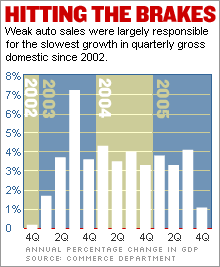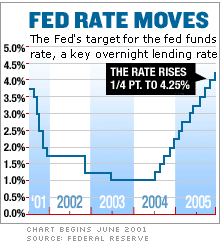|
GDP posts smallest gain in 3 years
Far less growth than forecasts in the fourth quarter, as economy manages only 1.1% annual rate gain.
NEW YORK (CNNMoney.com) - The nation's economy grew at its slowest pace in three years in the fourth quarter, according to the government's gross domestic product report Friday, which came in far weaker than economists' forecasts. The broad measure of the nation's economic activity showed an annual growth rate of 1.1 percent in the fourth quarter, down from the 4.1 percent growth rate in the final reading of third-quarter growth. Economists surveyed by Briefing.com had forecast a 2.8 percent growth rate in the fourth quarter.
Still even with the big decline in GDP growth in the quarter, the economy ended up growing at a 3.5 percent rate over the course of the full year, although that also was down from the 4.2 percent growth rate posted for 2004. Treasury Secretary John Snow tried to downplay the disappointing report on the nation's economic strength. "The preliminary estimate of fourth quarter 2005 GDP is inconsistent with the underlying strength of the U.S. economy," he said in a statement. "I would not read too much into today's numbers.� They are somewhat anomalous, reflecting some special factors. They are not consistent with other data on the U.S. economy which paint a picture of good growth." But others suggested that the report showed some underlying problems facing the U.S. economy in spite of earlier strength. And even economists who see better growth ahead than reported for the fourth quarter said the report raises concerns that the slowdown could be more significant the previously expected. "The sharp pullback in economic growth during the final three months of 2005 shows the law of gravity has not been repealed," said Bernard Baumohl, executive director of the Economic Outlook Group. "When consumers are burdened with heavy debt loads, rising interest rates, higher energy costs, no personal savings and household income growth that falls below inflation, something had to give. This retrenchment in spending was generally foreseen, though economists weren't sure on the timing and magnitude." U.S. stocks opened higher an hour after the report.. Anthony Chan, chief economist for JPMorgan Private Client Services, said that any concern among investors about slower growth was more than balanced by their glee that the report could stop the Federal Reserve from raising interest rates after its Jan. 31 meeting, at which another quarter-percentage point hike is widely expected. "The collapse of growth will serve as an incentive to stop the Fed from overshooting (on rate hikes)," said Chan. Still the inflation readings in the report did relatively little to assure that the Fed will not keep raising rates in an effort to keep prices in check. The personal consumption price index was up 2.6 percent in the quarter, while prices excluding food and energy rose 2.2 percent, up from a 1.4 percent gain in the third quarter. "There's a little disappointment the (price readings) weren't a little slower, given the collapse in growth," said Chan. David Wyss, chief economist for Standard & Poor's, said the GDP report changed his mind about what the Fed would do on rates. "At this point I think the Fed pauses after the next rate hike," he said. "I had been looking for one more hike, although I had thought the chances were just a little better than 50-50. Now I think it's a little less than 50-50. Of course we'll get a lot more numbers before that Fed meeting (March 28)." Wyss said the inflation numbers in the GDP report were in line with his forecasts as well as within the range that the Fed is looking for in terms of price stability. Spending on cars, planes, war falls
A big part of the slowdown was a 17 percent drop in spending on durable goods in the quarter, particular on cars and aircraft, as well as an unexpected 13 percent drop in government spending on national defense. A nearly month-long strike at Boeing in September affected aircraft deliveries in the third quarter. And auto purchases, which saw sales record in the summer due to "employee pricing" offers from the Big Three automakers, fell 8 percent compared to a year earlier and 18 percent compared to the third quarter of 2005 due to the lack of remaining 2005 models that normally would have been purchased in the fall. The drop in spending on motor vehicles was responsible for a 2.06 percentage point drop in the GDP by itself. The drop in military spending accounted for another 0.66 percentage point decline in the fourth quarter GDP, after adding 0.46 percentage point to the third quarter GDP growth. "We knew the car sector was weak. Almost the entire surprise was the drop in government defense spending," said Wyss, commenting on the surprise. "Maybe the war is over but more likely you often get these oddities at the beginning of the fiscal year (that starts Oct. 1) because Department of Defense plays cash management games." Wyss said that because of the impact of lower defense spending in this report, he thinks it's too soon to worry about the economy growing significantly slower than most forecasts of between 2 and 3 percent for all of 2006. The risk of an actual recession, or contraction in the U.S. economy, is even less. "I am confident the Pentagon will be spending more money at some time in 2006," Wyss said. "Part of the problem, a lot of the quarterly data has been distorted by (Hurricane) Katrina. We need another quarter to figure out what's going on. I think it's clear things are slowing down, the question is how much they're slowing down." Chan agrees that it's too soon to predict that economic growth has run out of gas. "There are plenty of other things to suggest we'll see positive growth. But it raises questions whether the growth will be less than expected," said Chan. The most immediate impact could be making it more difficult for President Bush's speech writers to point to the strength of the economy in his State of the Union address Tuesday night. The president said Thursday that economic strength would be one of the subjects he will raise when campaigning for Republicans in this year's Congressional elections. "They don't have a lot of tail wind with this number," he said.
For more news on the economy and what it means to you and your investments, click here. |
|




